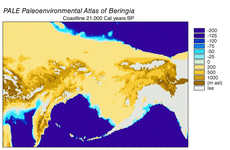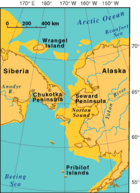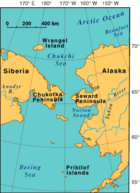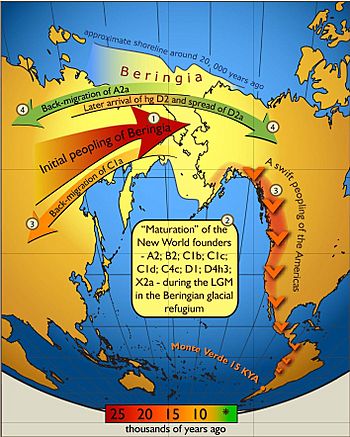Beringia facts for kids
The Bering land bridge was a large strip of land that connected what is now Alaska and eastern Siberia. This happened many times during the ice ages, especially in a period called the Pleistocene. At its biggest, this land bridge was about 1,000 miles (1,600 km) wide from north to south.
Even though it was an ice age, this land bridge didn't have huge glaciers. This was because there wasn't much snowfall. Winds from the Pacific Ocean dropped their moisture as snow over mountains that were already covered in ice.
This vast area, including the land bridge, was a huge grassland called Beringia. It stretched for hundreds of miles into both continents. Scientists believe a small group of humans, maybe a few thousand, lived in Beringia during the ice age. They were separated from other groups in Asia for at least 5,000 years. Around 16,500 years ago, these people began to move into the Americas. This happened when the large American glaciers that blocked their path melted.
Contents
What is the Bering Land Bridge?
The Bering land bridge is a very important part of Earth's history. It shows us how the world changed during past ice ages. It also helps us understand how humans spread across the globe.
How the Land Bridge Formed
Today, the Bering Strait, the Chukchi Sea to the north, and the Bering Sea to the south are all shallow seas. But during times of global cooling, like the most recent ice age, a lot of water turned into ice. This ice formed huge ice caps in the Arctic and Antarctica.
When so much water was locked up in ice, sea levels around the world dropped a lot. This drop in sea level exposed shallow parts of the ocean floor, creating land bridges. Later, when the ice melted, these areas became covered by water again.
Other land bridges formed in a similar way around the world. For example, about 14,000 years ago, Australia was connected to New Guinea and Tasmania. The British Isles were also connected to Europe. And the dry basin of the South China Sea linked islands like Sumatra, Java, and Borneo to the Asian mainland.
When Beringia Appeared
The land mass called "Beringia" appeared and disappeared several times during the Pleistocene epoch. This happened as global sea levels rose and fell.
Scientists believe the Beringian land bridge existed during an ice age that happened before 35,000 years ago. It also appeared more recently, between 22,000 and 7,000 years ago. The strait between Asia and North America reopened about 15,500 years ago. By about 6,000 years ago, the coastlines looked much like they do today.
Humans and the Land Bridge
The Bering land bridge is very important because it allowed humans to travel from Asia to the Americas. This major human migration is thought to have happened about 25,000 years ago.
One study by a scientist named Hey suggests that only about 70 people who crossed this land bridge left their genetic mark on people living today. This means that a very small group of people were the ancestors of many Native Americans.
Images for kids
See also
 In Spanish: Puente de Beringia para niños
In Spanish: Puente de Beringia para niños











